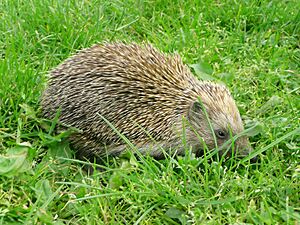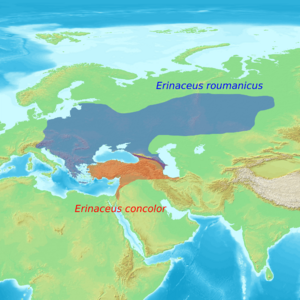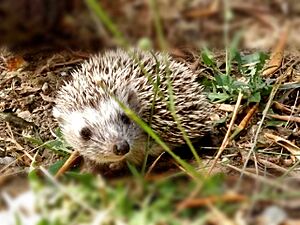Southern white-breasted hedgehog facts for kids
Quick facts for kids Southern white-breasted hedgehog |
|
|---|---|
 |
|
| Conservation status | |
| Scientific classification | |
| Genus: |
Erinaceus
|
| Species: |
concolor
|
 |
|
| Range of the southern white-breasted hedgehog (red) | |
The southern white-breasted hedgehog (Erinaceus concolor) is a small, spiky mammal. It is also sometimes called the white-bellied hedgehog or white-chested hedgehog. These hedgehogs live naturally in parts of Eastern Europe and Southwestern Asia. They are becoming popular as pets in countries like the United States and Iran.
Contents
What Does the Southern White-Breasted Hedgehog Look Like?
This hedgehog looks very similar to the European hedgehog (E. europaeus). However, you can easily tell them apart. The southern white-breasted hedgehog has a white spot on its chest.
These hedgehogs usually weigh between 680 to 900 grams. When they hibernate, their body weight does not drop below 600 grams.
Where Do Southern White-Breasted Hedgehogs Come From?
The southern white-breasted hedgehog became a separate type of hedgehog because of mountains. The Caucasus Mountains played a big part in dividing these hedgehogs. This split them into southern and northern groups.
Some of these hedgehogs live north of the Caucasus Mountains, in Russia. Others live in countries like Turkey, Iran, and Israel. This shows how widely spread this species is.
How Are Southern White-Breasted Hedgehogs Related to Others?
For a long time, scientists thought the southern white-breasted hedgehog and the northern white-breasted hedgehog were the same species. The northern white-breasted hedgehog lives in Eastern Europe and Russia. But new studies show they are actually different species.
It is interesting that the southern white-breasted hedgehog and the European hedgehog can have babies together. This means they can hybridize.
Relatives of the Southern White-Breasted Hedgehog
Some relatives of the southern white-breasted hedgehog include the West European hedgehog (Erinaceus europaeus) and the Northern white-breasted hedgehog (Erinaceus roumanicus). These two species can reproduce with each other. When they do, they create hybrids.
Scientists have studied the genes of these hedgehogs. They found that the northern white-breasted hedgehogs have more active genes in the hybrid species than the West European hedgehog.
Behaviour and Life Cycle
Like most hedgehogs, the southern white-breasted hedgehog lives in many different places. These include forests with trees that lose their leaves, parks, and gardens. Their diet is also similar to other hedgehogs. They mostly eat insects, slugs, snails, and worms.
They also eat beetles that are toxic. Luckily, these hedgehogs are immune to the toxins in these beetles.
Reproduction
The breeding season for these hedgehogs is between March and July. After being pregnant for about 6 weeks, a mother hedgehog can have up to 7 babies.
Hibernation
Southern white-breasted hedgehogs hibernate from November to March. This means they go into a deep sleep during the cold winter months. Unlike their European relatives, these hedgehogs do not dig dens. Instead, they prefer to build nests out of grass in quiet, hidden spots.
Health and Parasites
Southern white-breasted hedgehogs can carry different kinds of parasites. These include ticks and fleas, which live on their skin. Because these hedgehogs are becoming popular pets, there is a small risk. They could pass on diseases that can affect both animals and humans. These are called zoonotic diseases.
Lungworm Infection
Another type of parasite found in these hedgehogs is lungworm. There are two main types of lungworms that can infect them: Crenosoma striatum and Capillaria aerophila. Southern white-breasted hedgehogs can get one or both types of these infections. These infections can be very serious and even life-threatening.
Some signs of lungworm include losing weight, having trouble breathing, and being less active. Scientists have found a good way to treat lungworm in these hedgehogs. They can give them a single dose of a medicine called Moxidectin/Praziquantel.
Bartonella Infection
A study in 2016 looked at 57 southern white-breasted hedgehogs. It found that 5 of them had a Bartonella infection. This infection is caused by a type of bacteria. This study was the first time that Bartonella DNA was found in hedgehogs.



